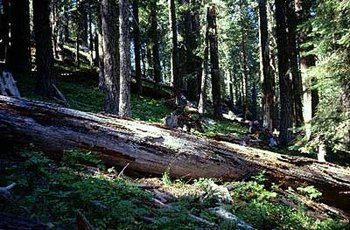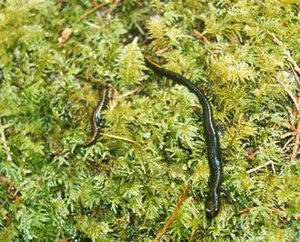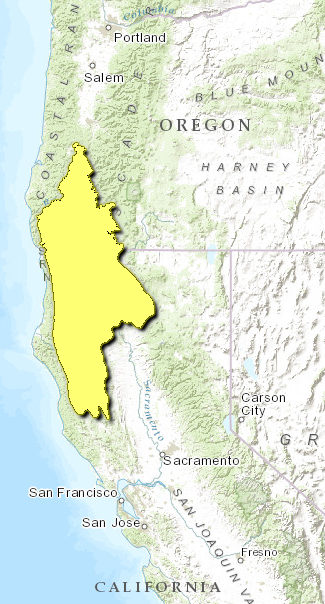Klamath-Siskiyou forests
Introduction Located in northwestern California (Klamath-Siskiyou forests) and southwestern Oregon, complex terrain, geology, climate, and biogeographic history have created one of the Earth’s most extraordinary expressions of temperate biodiversity in the Klamath and Siskiyou Mountains. Although well-known among biologists, few North Americans realize the uniqueness and importance of the species and communities in this ecoregion. Indeed, logging, mining, road building, and grazing continue to be intensive and pervasive threats to this area. To date no strict protected areas have been established in this rich region.
Biological Distinctiveness
The Klamath-Siskiyou forests ecoregion is considered a global center of biodiversity, a World Conservation Union (IUCN) Area of Global Botanical Significance (1 of 7 in North America), and is proposed as a World Heritage Site and UNESCO Biosphere Reserve. The biodiversity of these rugged coastal mountains of northwestern California and southwestern Oregon has garnered this acclaim because the region harbors one of the four [[rich]est] temperate coniferous forests in the world (along with the Southeastern conifer forests of North America, forests of Sichuan, China, and the forests of the Primorye region of the Russian Far East), with complex biogeographic patterns, high endemism, and unusual community assemblages. A variety of factors contribute to the region’s extraordinary living wealth. The region escaped extensive glaciation during recent ice ages, providing both a refuge for numerous taxa and long periods of relatively favorable conditions for species to adapt to specialized conditions. Shifts in climate over time have helped make this ecoregion a junction and transition zone for several major biotas, namely those of the Great Basin, the Oregon Coast Range, the Cascades Range, the Sierra Nevadas, the California Central Valley, and Coastal Province of Northern California. Elements from all of these zones are currently present in the ecoregion’s communities. Temperate conifer tree species richness reaches a global maximum in the Klamath-Siskiyous with 30 species, including 7 endemics, and alpha diversity (single-site) measured at 17 species within a single square mile (2.59 square-kilometers (km2)) at one locality. Overall, around 3,500 plant species are known from the region, with many habitat specialists (including 90 serpentine specialists) and local endemics.
 Oregon Caves NM, Oregon, USA. (Photograph by David Olson) The great heterogeneity of the region’s biodiversity is due to the area’s rugged terrain, very complex geology and soils (giving the region the name "the Klamath Knot"), and strong gradients in moisture decreasing away from the coast (e.g., more than 300 centimeters (cm) or 120 inches per year to less than 50 cm or 20 inches per year). Habitats are varied and range from wet coastal temperate rainforests to moist inland forests dominated by Douglas fir (Pseudotsuga menziesii), Pinus ponderosa, and P. lambertiana mixed with a variety of other conifers and hardwoods (e.g., Chamaecyparis lawsoniana, Lithocarpus densiflora, Taxus brevifolia, and Quercus chrysolepis); drier oak forests and savannas with Quercus garryana and Q. kelloggii; serpentine formations with well-developed sclerophyllous shrubs; higher elevation forests with Douglas fir, Tsuga mertensiana, Abies concolor and A. magnifica; alpine grasslands on the higher peaks; and cranberry and pitcher plant bogs. Many species and communities have adapted to very narrow bands of environmental conditions or to very specific soils such as serpentine outcrops. Local endemism is quite pronounced with numerous species restricted to single mountains, watersheds, or even single habitat patches, tributary stream banks, or springs (e.g., herbaceous plants, salamanders, carabid beetles, land snails). Such fine-grained and complex distribution patterns means that any losses of native forests or habitats in this ecoregion can significantly contribute to species extinction. Several of the only known localities for endemic harvestman, spiders, land snails, and other invertebrates have been heavily altered or lost through logging within the last decade, and the current status of these species is unknown. Unfortunately, many invertebrate species with distribution patterns and habitat preferences that make them prone to extinction, such as old growth specialist species, are rarely recognized or listed as federal endangered species. Indeed, 83 species of Pacific Northwest freshwater mussels and land snails with extensive documentation of their endangerment were denied federal listing by the U.S. Fish and Wildlife Service in 1994.
Oregon Caves NM, Oregon, USA. (Photograph by David Olson) The great heterogeneity of the region’s biodiversity is due to the area’s rugged terrain, very complex geology and soils (giving the region the name "the Klamath Knot"), and strong gradients in moisture decreasing away from the coast (e.g., more than 300 centimeters (cm) or 120 inches per year to less than 50 cm or 20 inches per year). Habitats are varied and range from wet coastal temperate rainforests to moist inland forests dominated by Douglas fir (Pseudotsuga menziesii), Pinus ponderosa, and P. lambertiana mixed with a variety of other conifers and hardwoods (e.g., Chamaecyparis lawsoniana, Lithocarpus densiflora, Taxus brevifolia, and Quercus chrysolepis); drier oak forests and savannas with Quercus garryana and Q. kelloggii; serpentine formations with well-developed sclerophyllous shrubs; higher elevation forests with Douglas fir, Tsuga mertensiana, Abies concolor and A. magnifica; alpine grasslands on the higher peaks; and cranberry and pitcher plant bogs. Many species and communities have adapted to very narrow bands of environmental conditions or to very specific soils such as serpentine outcrops. Local endemism is quite pronounced with numerous species restricted to single mountains, watersheds, or even single habitat patches, tributary stream banks, or springs (e.g., herbaceous plants, salamanders, carabid beetles, land snails). Such fine-grained and complex distribution patterns means that any losses of native forests or habitats in this ecoregion can significantly contribute to species extinction. Several of the only known localities for endemic harvestman, spiders, land snails, and other invertebrates have been heavily altered or lost through logging within the last decade, and the current status of these species is unknown. Unfortunately, many invertebrate species with distribution patterns and habitat preferences that make them prone to extinction, such as old growth specialist species, are rarely recognized or listed as federal endangered species. Indeed, 83 species of Pacific Northwest freshwater mussels and land snails with extensive documentation of their endangerment were denied federal listing by the U.S. Fish and Wildlife Service in 1994.
Rivers and [[stream]s] of the Klamath-Siskiyou region support a distinctive fish fauna, including nine species of native salmonids (salmon and trout), and several endemic or near-endemic species such as the tui chub (Gila bicolor), the Klamath small-scale sucker (Catostomus rimiculus), and the coastrange sculpin (Cottus aleuticus). Many unusual aquatic invertebrates are also occur in the region.
Conservation Status
Habitat Loss
Only 25 percent of the ecoregion is considered to be relatively intact.
Remaining Blocks of Intact Habitat
 Del Norte's salamander. (Photograph by Dominic Dellasala) Larger blocks of relatively intact habitat include the Trinity Alps (1,910 km2), Marble Mountain (769 km2), Whiskeytown-Shasta (657 km2), Kalmiopsis (649 km2), Eel River (586 km2), Siskiyou (569 km2), and Yolla Bolly-Middle Eel River Nationa Forest Wilderness areas (555 km2), and the Klamath Wild & Scenic River (669 km2). Most of these larger blocks encompass higher elevation [[habitat]s]. Few large blocks of lower elevation undisturbed habitat remain. The Dillon Creek watershed represents one of the last remaining lowland forest blocks, but is still unprotected.
Del Norte's salamander. (Photograph by Dominic Dellasala) Larger blocks of relatively intact habitat include the Trinity Alps (1,910 km2), Marble Mountain (769 km2), Whiskeytown-Shasta (657 km2), Kalmiopsis (649 km2), Eel River (586 km2), Siskiyou (569 km2), and Yolla Bolly-Middle Eel River Nationa Forest Wilderness areas (555 km2), and the Klamath Wild & Scenic River (669 km2). Most of these larger blocks encompass higher elevation [[habitat]s]. Few large blocks of lower elevation undisturbed habitat remain. The Dillon Creek watershed represents one of the last remaining lowland forest blocks, but is still unprotected.
Degree of Fragmentation
The biological communities of this ecoregion are naturally heterogeneous, but logging has greatly increased fragmentation. Species that are found only within narrow altitudinal belts are particularly sensitive to the isolation, fragmentation, and reduction of their habitat.
Degree of Protection
Higher elevation habitats are well represented within a system of protected areas (e.g., Wilderness Areas), but midd
le and lower elevation sites are poorly protected. The ecological integrity of habitats within Wild and Scenic River areas are often compromised by land-use in surrounding areas and linear habitat configurations that do not favor viable ecological and population dynamics.
Types and Severity of Threats
The Klamath-Siskiyou's native communities (Ecosystem) have been heavily impacted by commercial logging, fire suppression, mineral extraction, road building, and grazing of sheep and cattle. Many of the larger rivers and tributaries have been severely degraded by dredging for gold, toxic runoff from mining operations, and sedimentation and associated changes from excessive and poorly managed logging. Introduced species, particularly in aquatic habitats, have altered many natural communities.
Suite of Priority Activities to Enhance Biodiversity Conservation
- Strict protection or remaining roadless areas, lowland forest habitats, the last remaining intact watersheds, and riparian habitats is immediately needed.
- Because of the globally outstanding biodiversity of this region, all logging of undisturbed native forests should be halted and restoration efforts should be initiated to regain ecological viability for remaining native habitats.
- Implementation of controlled burns to reverse problems associated with decades of fire suppression is critical.
- There should be immediate protection and restoration of lowland habitats that act as linkages between higher elevation protected areas.
- Cattle and sheep grazing should be eliminated from alpine and high elevation habitats, as this contributes to significant damage of Darlingtonia bogs and other fragile [[habitat]s].
- Conservation analyses need to be completed for the region to ensure adequate representation and landscape-level integrity in proposed conservation strategies. Some specific activities include:
- Preserve and protect existing roadless areas, particularly those providing linkages between existing protected areas such as the Kalmiopsis, Siskiyou, Marble Mountain, and Trinity Alps wilderness areas. About 60 percent of them have been designated late successional reserves under the Clinton Forest Plan, but need legislative action for permanent protection.
- Protect all remaining intact blocks of low-elevation forests, an increasingly rare habitat type due to excessive logging. The Dillon Creek watershed is one of the last larger blocks of lowland forest, and also maintains one of the last intact altitudinal gradients in the region.
- Establish a biodiversity reserve system centered on Klamath National Forest, or a system of parks and/or reserve areas, including a Siskiyou National Park in southern Oregon.
- Reserve system should conform to watersheds critical to salmon. Spawning [[stream]s] are being degraded by [[sediment] deposition and exposure to solar radiation caused by logging. Add key watersheds, such as the Illinois and North Fork Smith rivers, South Fork Chetco, and Eagle Creek to the reserve system.
- Take steps to protect downstream habitat for salmon and other species on public and private land. End overfishing of salmon stocks, particularly wild coho and south coastal Oregon chinook. Place adequate fish screens on irrigation diversions. Prevent chronic de-watering of streams in the Illinois Valley and elsewhere that kill thousands of juvenile salmon. Remove or modify earthen dams that block access to headwater streams. Correct hatchery practices damaging to wild [[population]s].
- Preserve the Port Orford cedar (Chamaecyparis lawsoniana), an ecoregional endemic conifer, by stopping the spread of an exotic water-borne root fungus that is threatening this species with extinction. The fungus is spread by vehicles traveling on roads and by logging activity.
- Reduce accumulated fuel loads (built up by decades of fire suppression) in the Siskiyou and Klamath Mountains to reduce the chance of catastrophic wildfire. Salvage logging is not an [[ecological]ly]-sound prescription to achieve this goal.
- Bring Bureau of Land Management (BLM) forested land under the jurisdiction of the USDA Forest Service. Focus the Forest Service's ecosystem management policy by establishing a panel of independent scientists to develop standards for harvesting timber that are in accord with conservation of the biological diversity of the system.
- The federal government should purchase private lands that harbor or are needed to sustain endangered and threatened species.
- The federal government should promote improved forest practices on private land as a complement to ecologically sustainable management of federal forests.
- Undertake recovery of declining species such as fisher (Martes pennanti) and wolverine (Gulo gulo), and reintroduce extirpated species such as wolf (Canis lupus) and grizzly (Ursus arctos). The relatively intact condition of the Klamath-Siskiyou forests ecoregion provides a rare opportunity for recovery of large carnivores in the West.
- Declare a moratorium on logging and road building in the Blue, Somes, Red Cap, Perch, Sucker (China Left timber sales), Monte and Biose creek watershed. These areas contain key salmonid watersheds and unprotected low elevation forests and roadless areas. The Forest Supervisor should be directed to enforce the roadless area directive by restoring the roadless area boundaries originally identified under the RARE II process in these areas.
- Prohibit road reconstruction activities in the Dillon Creek watersheds where the New Year’s Day storm of 1997 caused a number of significant mudslides in watershed already damaged by years of logging and road building. Roads in this area should be decommissioned (not repaired) to assist in recovery of threatened coho and to allow watersheds to recover from cumulative impacts. The administration should use federal highway funding available to these forests as a result of storm disaster relief to decommission roads in watersheds at high risk of subsequent flooding and mudslides.
- Withdraw all timber sales in roadless areas, late successional reserves, and key salmonid watersheds in the Siskiyou Nation Forest, including the Mineral Fork, Quosatana Roadless Area, and Smith River National Recreation Area timber sales. The Forest Service has offered 'reserve' timber in these areas that would greatly diminish the ecological integrity of the reserves and undermine the credibility of the President’s Northwest Forest Plan.
Conservation Partners
- The California Native Plant Society
- Earthdesigns
- Headwaters
- Humboldt State University
- Klamath Forest Alliance
- The Nature Conservancy
- The Nature Conservancy of California
- Northcoast Environmental Center
- Siskiyou Regional Education Project
- The Wildlands Project
Relationship to Other Classification Schemes
The Klamath-Siskiyou forests ecoregion corresponds to Omernik’s Klamath Mountains ecoregion and roughly overlaps with Bailey’s Klamath Mountains and Southern Cascades sections (M261A, M261D).
Additional Information on this Ecoregion
- For a shorter summary of this entry, see the WWF WildWorld profile of this ecoregion.
- To see the species that live in this ecoregion, including images and threat levels, see the WWF Wildfinder description of this ecoregion.
- World Wildlife Fund Homepage
| Disclaimer: This article is taken wholly from, or contains information that was originally published by, the World Wildlife Fund. Topic editors and authors for the Encyclopedia of Earth may have edited its content or added new information. The use of information from the World Wildlife Fund should not be construed as support for or endorsement by that organization for any new information added by EoE personnel, or for any editing of the original content. |

